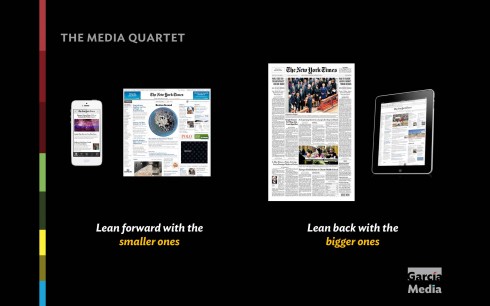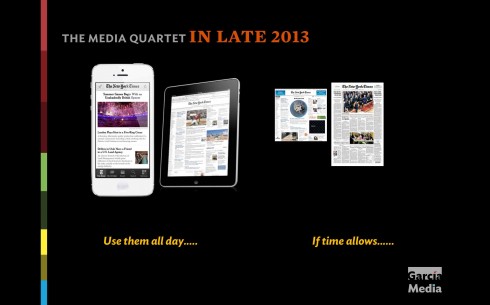This is the weekend edition of TheMarioBlog and will be updated as needed. The next edition is Monday, Oct. 28
Update 1: Friday, Oct. 25, 08:39 EST, Tampa, Florida
TAKEAWAY: The tablet is moving center stage in the midst of the new media quartet reorganization.

Media quartet as originally displayed

Media quartet: circa late 2013
We definitely are in the midst of a fast-evolving media business. It is not only challenging to keep up with the changes, let alone the time to digest them and to process them so that we can make sense of what is going on.
Take, for example, the media quartet to which I refer often in this blog and in all of my training workshops.
It is still a media quartet, for sure: phone, online, print and tablet.
But we are seeing dramatic changes in how those four pieces perform, and the degree of preference among users.
The major change: how the tablet is moving from a 100% lean-back platform, primarily used during evening hours, to an all-day affair: the platform of choice for many to read news throughout the day.
It changes the dynamics. It poses challenges for what content we put on the tablet. It encourages us to think that perhaps the tablet becomes a two-track device: one that we come to at various times during the day to get updated on the news, and one that we lie down in bed or on the couch with at the end of the day to enjoy a long narrative or multimedia piece, watch photo galleries and videos.
“I would say tablet use in general is declining as a lean-back experience because of the growth of smaller, lighter tablets with greater mobility,” says Raju Narisetti, News Corp Senior Vice President, Strategy.
J Ford Huffman, a former USA Today deputy managing editor, had this to say about the changes we are witnessing about the positioning of mobile devices:
PROBABLY it is reshuffling
as it does every time somebody improves the technology platform, but the reshuffling is incremental. The dance is not over, and it takes two to tango—the technology and the tangibility.
Smaller devices win the day, it seems. It is also the reason we are now also spending more time looking at photos, using maps, playing games, checking the weather and social networking on mobile phones rather than desktop computers, according to recent research from Statista.
For now, I am still using the media quartet image of the four platforms in my presentations, but I have added a new one that best reflects what is happening right now. The smaller platforms continue to get stronger in preference for maps, games, networking and weather, even though most readers continue to get “news” via desktop computer.
Stay tuned!
Recent research on the subject:
Peak Times for Smart Devices: Primetime for Entertainment, Morning Commute for news
http://pandodaily.com/2013/09/26/peak-times-for-smart-devices-primetime-for-entertainment-morning-commute-for-news/
65% of Time Spent on Social Networks Happens on Mobile
http://mashable.com/2013/10/24/content-consumption-desktop-mobile/
Times readers spend 30 minutes with the tablet versus five on the website
http://www.pressgazette.co.uk/times-readers-spend-30-minutes-tablet-versus-five-website
Weekend reads of interest
Inside ‘The Atlantic’: How One Magazine Got Profitable by Going ‘Digital First’
http://mashable.com/2011/12/19/the-atlantic-digital-first/
Highlights:
Five years ago, no one could have foreseen that **The Atlantic**, a 154-year-old publication founded by a collective of New England intellectuals, would have become a leader in the so-called digital age.
With consecutive quarterly growth in both print and digital advertising sales, **The Atlantic** has emerged as a vanguard in an industry harassed by declining ad revenues and falling circulations. And the credit, its executives say, belongs to the “digital first” strategy it embraced four years ago.
India’s press faces an online future
http://india.blogs.nytimes.com/2013/10/22/indias-press-faces-an-online-future/?_r=0
Highlight:
Each new publisher faces an old Internet dilemma, one especially steep in India: making money.
OC Register’ President: It’s a Mistake Not to Invest in Print
http://mashable.com/2013/10/24/orange-county-register-print-first/
Highlight:
Quote from Eric Spitz, president and co-owner of Freedom Communications and its flagship newspaper, The Orange County Register
Local is where you can compete. We can’t compete nationally or internationally because we wouldn’t be able to avoid a world where our major competitions can give away their content for free. The New York Times’s major competitors will always be free — google.com, yahoo.com, cnn.com, foxnews.com. They’re making money elsewhere in business and they can run [their news arms] at break even or worse. But guess what you can’t Google? Local news. The news we create is unique and no one else is doing it. The news we create is unique and no one else is doing it.